Waterlow Centenary II

Introduction
Specimens
1900 'Provisional Neutrality'
British Railway Administration
Postage Due
Tibet
'Provisional Neutrality
Republic of China provisional neutrality
Statistical Department
Commercial Press
Waterlow
Locals
Perfins-Firmchops
Various
Bibliography
Introduction
Waterlow Revisited II *,
(English translation by Willem Verhulst)
In the March issue of the Dutch China Studygroup (no.118, 1998) the first part of a very important survey about the 'Waterlow Stamps' with the pictures of the drake, carp and goose was published. This is the second issue which gives you a review about overprints, perfins, firmchops, special chops and bisects. The description of the general part is finished with this article. We hope Jozef will be able to write more about the seperate values in the future.
Numbers printed In the first article, it was assumed that the numbers of stamps printed, as published in 'The Waterlow Issue of 1898', are based on the archives up to April 1912. Meanwhile, the library has acquired Chow's original publication (1937). This book mentions the numbers of stamps issued until 1 January 1913. For the watermarked stamps, the numbers mentioned in 'The Waterlow Issue of 1898' were used. A small part of the «c with watermark was used for the B.R.A. overprints, the number of which is not known. The survey below is based on this in formation:
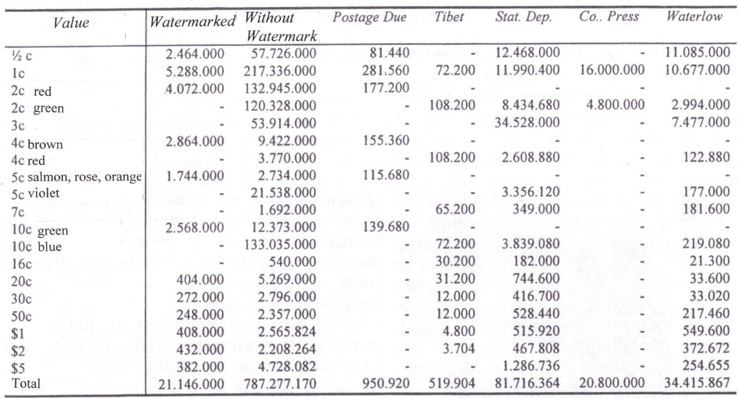

Specimens
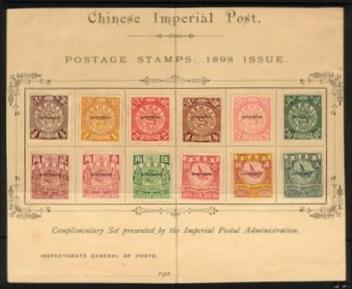
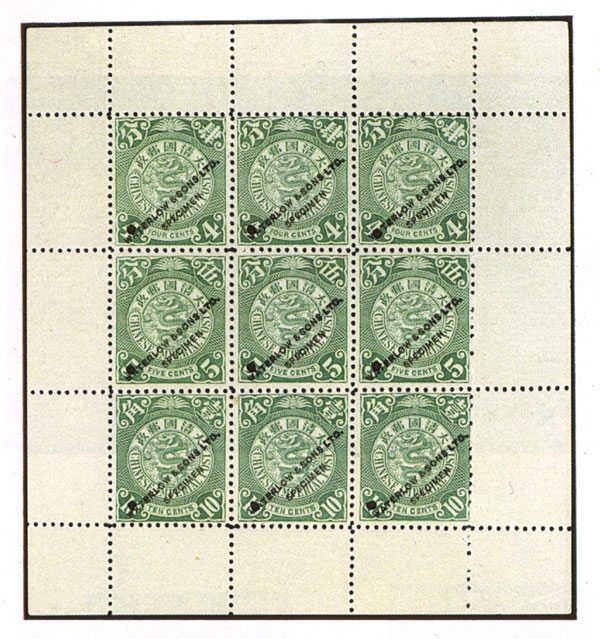
Specimen overprints serve two purposes. In the first place, they are used by other postal organizations and other parties interested. In the second place, they serve as promotional material, and occur as samples of no (postal) value. Of the first group, two overprints are known: a small horizontal (10x1 mm) one, and a slightly larger diagonal one (12.25x2 mm). The overprints were produced in China, on stamps stuck on presentation sheets. Three different sheets are known. An example of the second type is shown in the illustration above. Until now, I have only seen the overprint in black, but Wet terling (1985) also reports occurrences of the small overprint in red. All values occur with diagonal overprints, and the early values (SG 108-133) with horizontal ones. The red over print is said to occur only on stamps with watermarks. A se cond group of specimens are specimen overprints, produced by Waterlow & Sons. These can also be subdivided into two groups, one for Waterlow's own use, and the second to serve as promo tional material. The first group contains the colour proofs of stamps, with diagonal overprints, and a few sheets of the file-copies, horizontally overprinted with 'SPECIMEN'. The second group consists of imperforate stamps in colours unissu ed, diagonally overprinted with 'Waterlow & Sons Ltd. Speci men' and small sheets of 3x3 stamps bearing the same overprint. Four different overprints are known, in black and blue. These stamps and sheets are from the 'sample books' used by Waterlow's representatives. The small sheets have perfora tion 13.

1900 'Provisional Neutrality

These overprints were reportedly made in 1900, in order to take a stand against the Boxer Rebellion. The overprint is known in black and red on the 1c. There are two letters dated 6 February 1900, which, in my opinion, are merely fabricati ons, since the overprints were made on Die 3 of the 1c, which was not used until 1909 (see also Roseway, 1961)

British Railway Administration

After the Boxer Rebellion, the British were in charge of the Beijing-Tianjin-Shanhaiguan railway line. For a 'late fee', it was possible to post letters etc. direct at the station during the hour prior to the train's departure. The route had 5 sta tions (Beijing, Tianjin, Tonggu, Tongshan and Shanhaiguan), where mail could be handed in. For this 'late fee' of 5c, «c stamps with watermark were overprinted. The overprint occurs in green and black. The overprints were made per pane, i.e. per block of 5x4 stamps. It is therefore possible to plate each stamp. Only one pane of 20 is known to have an inverted overprint. There is no certainty as to the numbers printed; reports vary from 9,600 (2,400 green and 7,200 black) to num bers around 2,000. Wasserman (1973) is inclined to leave the number at 1,920. Because the service was unsuccessful (being too expensive), these stamps were only used for a brief period of time (20 April-20 May 1901). The unused copies of the stamps that are on the market originate from private collecti ons of military personnel stationed in the area. Overprints with a smaller 5 on unwatermarked stamps are forgeries.

Postage Due
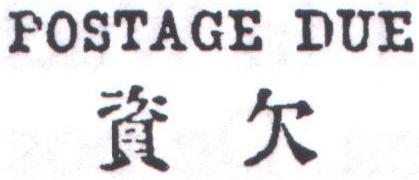
The increase in the number of post offices, especially in re mote areas, also created a demand for stamps. By way of an emergency measure (Waterlow's being unable to deliver the standard 'postage due' stamps in time), an overprint was pro duced, for which a number of Waterlow stamps was used. The overprint occurs on the «c, 1c, 2c, 4c, 5c and 10c. As far as we know, only complete sheets were used for the overprints. The basic unit is a pane (5x4). In position 8, the 'chien' character is moved to the right, while position 25 shows a thickening in the left leg of the 'chien'. Apart from that, there is another deviation, which does not occur on all the panes, viz. the damage to the bottom leg of the E in DUE. Whe never it occurs, it is in position 18. See survey 1 for the number of copies printed. The remaining stocks were sold unu sed in November 1904, following the introduction of the defi nitive series (SG D143-150). According to Kohl, all the valu es, except the «c and the 1c, were still available at post offices as late as 1909. Forgeries of the Postage Due over print exist, but are rare and of poor quality.

Tibet
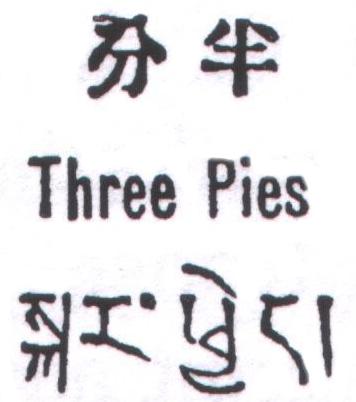
At the end of 1909, the Chinese started a campaign against Tibet in order to enforce their claim of overlordship. Lhasa was captured in February 1910. At first, Waterlow stamps wit hout overprints were used; overprinted stamps were used from March 1911 onwards. After the revolution, the Chinese troops were withdrawn. The remaining stamps were later sold at Beij ing post office. See survey 1 for the number of copies prin ted. There is some uncertainty as to these numbers. Ma indica tes that 2,700 copies of the $2 were sold. Fuchs (1988) con cludes, albeit not very convincingly, that 3,744 copies must have been produced. Presumably, the stamps were overprinted at the Postal Supply Department in Shanghai. Three settings exist, viz. the dollar values overprint of 48 (6x8), the 2 and 3 as. overprint of 2x25 (5x5) and the remainder with 2x20 (5x4). The three pies occurs with the overprint inverted. Two deviations occur in the overprint of the 3 annas: position 23 shows a disfiguring of the Tibetan character and position 39 has an inverted 'S' in the overprint. Forgeries of the over print as well as the cancellation stamps occur, as do combina tions of both, also on letters.

'Provisional Neutrality'

Following the 1911 Revolution in Wuchang, one province after the other joined the revolutionaries. The postal services were unsure what to do, and overprinted the current series with 'provisional neutrality'. The first shipment of these stamps was sent to Foochow and went on sale there on 30 January. Af ter protests, the series was withdrawn after a few days. Only the 3c, $1, $2 and $5 were sold, the remainder was never issu ed officially. The following numbers were sold: 6,000 of the 3c, 96 each of the $1 and $2 and 288 of the $5. Many forgeries of this issue occur, not only on used stamps: of the 3c there even exists a sheet of 50 with a forged overprint.

Republic of China provisional neutrality
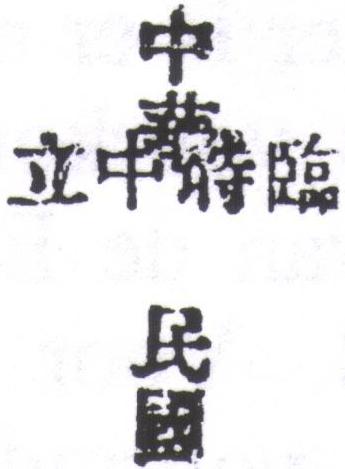
After the above series had been withdrawn, these stamps were again overprinted with 'Zhong Hua Min Guo, Republic of China', because it was thought wasteful to have the overprinted stamps destroyed. These stamps were sold in Hankou, Nanjing and Changsha from 20 March 1912 onwards. This series also met with criticism and was withdrawn shortly afterwards. Ma indicates the follwing numbers:

* A letter from Nanjing District Postmaster C. Rousse exists, in which the sale of the 1c is estimated at 1,000.
The other overprinted values were not officially issued. Ma reports that there are still large stocks of these stamps, 2,100 of the values up to and including 10c, 1,400 of the va lues up to and including 50c and 700 of the dollar values. Dignitaries, including President Roosevelt, were presented with complete sets. In a very interesting article, Peter Hol combe (1975), however, doubts the correctness of Ma's report, proving that a large part of the unissued values was printed at a later time. Nevertheless, there exist panes of the «, 5, 20 and 30c bearing this overprint.

Republic of China provisional neutrality

After the above series had been withdrawn, these stamps were again overprinted with 'Zhong Hua Min Guo, Republic of China', because it was thought wasteful to have the overprinted stamps destroyed. These stamps were sold in Hankou, Nanjing and Changsha from 20 March 1912 onwards. This series also met with criticism and was withdrawn shortly afterwards. Ma indicates the follwing numbers:

* A letter from Nanjing District Postmaster C. Rousse exists, in which the sale of the 1c is estimated at 1,000.
The other overprinted values were not officially issued. Ma reports that there are still large stocks of these stamps, 2,100 of the values up to and including 10c, 1,400 of the va lues up to and including 50c and 700 of the dollar values. Dignitaries, including President Roosevelt, were presented with complete sets. In a very interesting article, Peter Hol combe (1975), however, doubts the correctness of Ma's report, proving that a large part of the unissued values was printed at a later time. Nevertheless, there exist panes of the «, 5, 20 and 30c bearing this overprint.
Statistical Department

Although this overprint with the text 'Republic of China' is known as the Statistical Department overprint, this is not its correct name. The stamps were overprinted at the Postal Supply Department (Pan, 1984). There are three important settings of this overprint, viz. for the sheets of 240, 200 and 48 stamps. The sheets of 240 and 200 were overprinted in complete sheets, in the process of which, according to Morgan, the left and bottom margins were removed, but a block of the 3c is known to have the bottom margin still intact. The setting of the dollar values is not known, but presumably a printing plate of 48 clich‚s was used which left the margins intact. The compositi on of the overprint plates is not known, but Morgan (1952) suggests that first one overprint was made from loose type (Sung Style, 5) and that 20, 25 or 48 copies were made on ma trix paper. There panes were then copied again and assembled as a printing plate. Many of these printing plates must have been produced. Inverted overprints occur on the following va lues: «c, 1c, 3c, 7c, 10c, $1 and $2. An inverted overprint of the 50c has been reported, but its status is doubtful. Of the $1, one sheet is known, of the $2 at least four. A proof of this overprint is also known to exist on rice paper
Commercial Press

This overprint, also with the text 'Republic of China', only occurs on the 1 and 2 c. The setting is 240 stamps, and, like the Statistical Department overprint, the sheets had the left and bottoms margins removed. Since four different inscriptions in the margins are known, there must have been at least four overprint plates, 3 for the 1c and 1 for the 2c. In all proba bility, the printplates were made from loose type. This is plausible, as the 1c shows a deviation in which the upper cha racter 'zhong' is moved to the right (Chan 167h). Inverted overprints of both values also occur.

Waterlow

All values were overprinted by Waterlow with 'Republic of Chi na' in characters of a more 'handwritten' type. There are set tings of 240, 200 and 48 stamps. The overprints were made on complete sheets, and the margins were left intact. The stamps used were especially printed for the purpose by Waterlow; they can be recognized by their colours, and, in some cases, by the Dies used. Morgan concludes that there were at least 9 over print plates for this series. The different values were not all issued at the same time. The «, 1 and 2c were issued in August 1912, the $5 in October, the 3c, $1 and $2 in November and the 5c in December 1912. The date of issue of the other values is not known. Only the 3c is known to occur with the overprint inverted.

Locals

The so-called local overprints are overprints made by the post offices themselves as a result of a letter from the Postmaster General, in which it was recommended that all references to the Qing dynasty should be removed from letter headings etc. Over 60 places are known to have produced these overprints. However, there are a few problems: the letter dates from Fe bruary 1912, yet most of the local overprints do not appear until the period May to September 1912. There is a strong as sumption that these overprints were mainly produced for phila telic reasons. The best-known overprints of Kienyang-fu, Chu kiachiao, Tuchanghsien and Hwangtu do bear strong philatelic features. 'Genuine' local overprints are relatively rare, with the possible exception of Guangzhou. Apart from that, the ma jor part of the local overprints available on the market are simply forgeries. The Tianjin overprint is known to have been made by an American journalist, and I also have great doubts myself with regard to the Tsinshan and Foochow overprints. Lane has the best listing of the locals.

Perfins-Firmchops
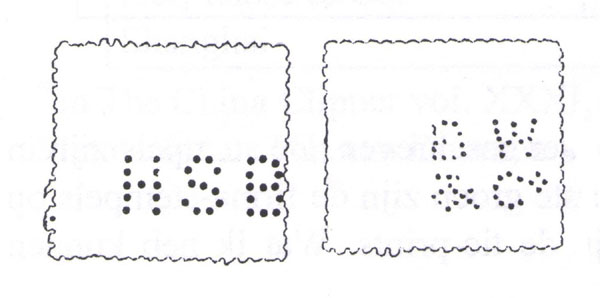
This enumeration should not exclude firmchops and perfins. Perfins are of course no overprints, but, let us say, imprints. Davey indicates the following perfins on Waterlow stamps:
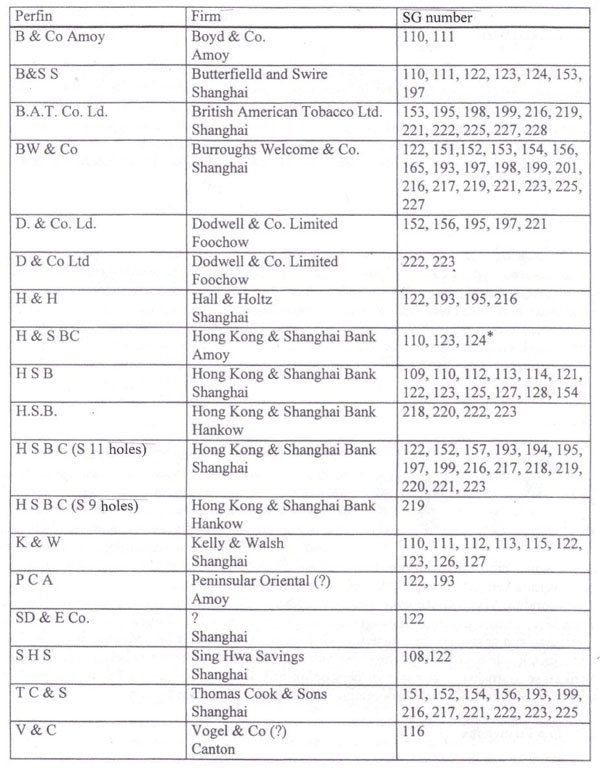
* Probably this is not 124, but 111.
Less has been written about firmchops. The chops can be divided into two groups: the first are the firmchops on the stamps, and the second are the tie-prints. I have been able to find the following chops:

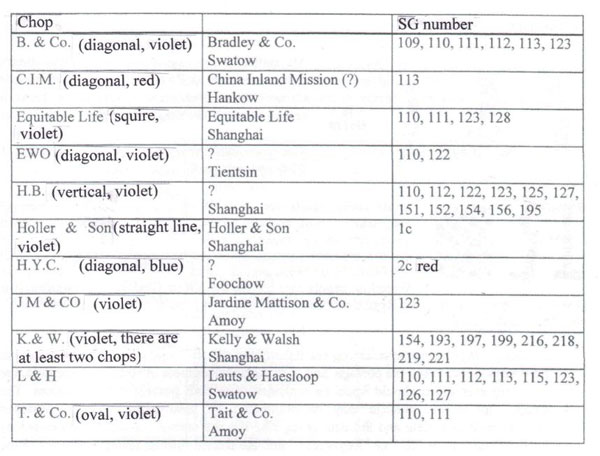
The second group are the tie-prints, i.e. the chops are put on, covering part of both the stamp and the envelope, after the stamp has been affixed. Since usually only a small part of the chop appears on the stamp, it is difficult to identify them. Identification is only possible when they occur on let ters.
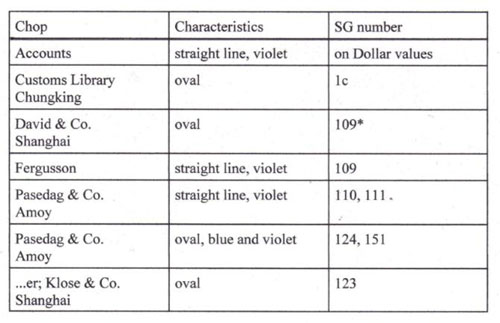
* In The China Clipper vol. XXXI, p. 92, this tie-print is ascribed to SG 122. This seems to be incorrect.
Thanks are due to Ton van Doornen for his indispensable assis tance in writing this chapter.

Various
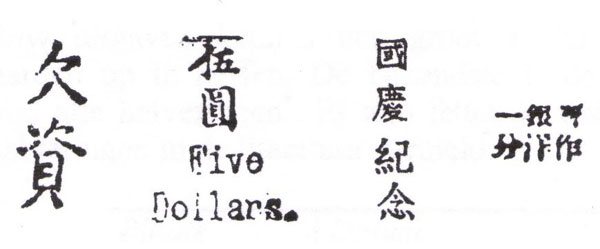
The final group of overprints discussed here deals with a num ber of which the status is unknown. They have been published over the years in The China Clipper. The last overprint origi nates from a D&O auction (Auction #10, lot 116).
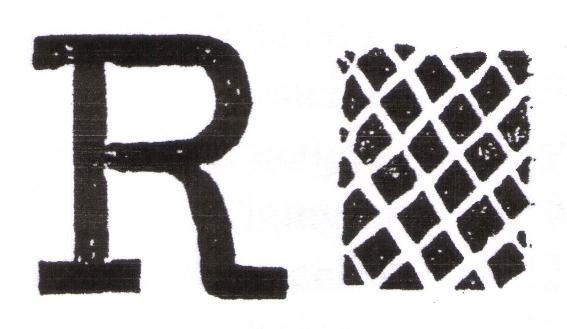
Firstly, there is a big capital R on stamps. This is a stamp used for registered mail and was used in a large number of places. Instructions indicated that the stamps needed for the postage proper and the stamps needed to cover the registration fee were to be affixed separately to the document. The latter were then obliterated by means of the R-stamp. During the first period, red ink was used, later to be followed by black. So far, only Chefoo and Newchwang have been found in red on Waterlow stamps. Article 21 of The Registration System, an appendix of the Postal Secretary's Circulars No. 2, 24 Novem ber 1897, reads as follows:
21. The postage stamp representing the registration fee should be affixed separately from the stamps representing the post age, and if an Acknowledgment of Receipt is required, the stamp representing it should again be separated from both postage and fee stamps. The stamps representing postage may be obliterated by means of the dater, provided obliteration is complete and the date is legible. The fee stamps should be obliterated by means of the stamps "R.", or "Registered", and the Return Receipt stamp by means of the mark "R.R."
(Appendix A47.1 The Revenue Surcharges China 1897)
A second obliteration, occurring only on the postage due over prints, is a kind of grille. The best explanation for this grille is that it occurs on postal items which have postage due on them, which the addressee refused to pay. Because the postage due fee remained uncollected, the stamps were once again obliterated by means of this 'grille' stamp.
Special chops

The only special obliteration chops occurring on Waterlow stamps are those for a beneficence congress in Shanghai, held between 26 and 28 May 1912. The colour of the ink used is purple.
Bisects
A large number of bisects of the Waterlow issues is known to exist; these were used to meet the temporary shortage of stamps of the various values. The Foochow bisect is the best known. At the same time, this is also the most forged of all the bisects.* Literally thousands of forgeries are known to circulate. Apart from that, the following bisects have been mentioned in literature on the subject:

Most of these bisects were not approved by postal authorities, but they were used nevertheless. Foochow, Chungking, Changsha, Hinganfu and Sunning are known to exist on letters, the others are only known from pieces of covers. I would appreciate if readers could fill in the question marks.
** W. Stones has carried out research into these forgeries, concluding that there are at least 27 different forgeries of the Foochow bisect. (Stones, 1992)

Bibliography
Davey, Paul N.; The Perfins of China Bettendorf, The China Stamp Society Inc., 1992
Denison, Ellery Specimen Prints of Stamps printed by Waterlow & Sons, Ltd. II. in The China Clipper, Vol. XXXII, No. 5, July 1968
Fuchs, Rainer Chinesische Post in Tibet. Ausgabe 1911, Mi.-Nr. 1-11 in Die China-Philatelie Nr. 80, 4. Quartal 1988
Holcombe, Peter The Neutrality Issues of 1912 in Journal of Chinese Philately, No. 177, Vol. 22, April 1975
Kauder, Warren G. Specimen Prints of Stamps printed by Waterlow & Sons, Ltd. in The China Clipper, Vol. XXXII, No. 3, March 1968
Lane, E.N. The Local Republican Overprints of 1911-1912. London, The Chi na Philatelic Society of London, 1985
Morgan, Henry G. Notes on the Waterlow Dragon Issue in The China Clipper, Vol. 16, No. 3, April 1952
Pan, A.S. The Historical Origin of Revenue Surcharges with the Statisti cal Department, Inspectorate General of Customs-I in Postal Service Today, No. 323, 16 November 1984
Roseway, Sir David "A Problem if Two Covers with "Neutrality" Overprinted Stamps" in Journal of Chinese Philately No. 94, Vol. 8, No. 5, June 1961
Stones, W. The Foochow Bisect Forgeries in Journal of Chinese Philately, No. 279, Vol. 39, No. 4, April 1992
Van Doornen, Ton Firma stempels en Perforaties I. in China Filatelie Vol. 11, No. 1, March 1979
Van Doornen, Ton Firma stempels en Perforaties, deel 2. in China Filatelie Vol. 23, No. 95, December 1991
Wasserman, Harold British Railway Administration Stamps of China in The China Clipper No. 205, Vol. 38, No. 1, November 1973
Wetterling, J.G. Handbook and Check List of Chinese Stamps. Part 2. J.G. Wet terling, 1985
